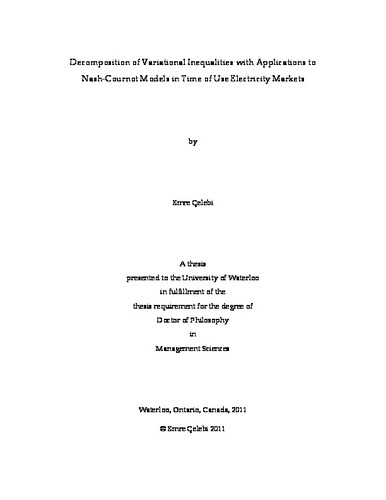| dc.contributor.author | Celebi, Emre | |
| dc.date.accessioned | 2011-08-29 16:39:39 (GMT) | |
| dc.date.available | 2011-08-29 16:39:39 (GMT) | |
| dc.date.issued | 2011-08-29T16:39:39Z | |
| dc.date.submitted | 2011 | |
| dc.identifier.uri | http://hdl.handle.net/10012/6163 | |
| dc.description.abstract | This thesis proposes equilibrium models to link the wholesale and retail electricity markets which allow for reconciliation of the differing time scales of responses of producers (e.g., hourly) and consumers (e.g., monthly) to changing prices. Electricity market equilibrium models with time of use (TOU) pricing scheme are formulated as large-scale variational inequality (VI) problems, a unified and concise approach for modeling the equilibrium. The demand response is dynamic in these models through a dependence on the lagged demand. Different market structures are examined within this context. With an illustrative example, the welfare gains/losses are analyzed after an implementation of TOU pricing scheme over the single pricing scheme. An approximation of the welfare change for this analysis is also presented. Moreover, break-up of a large supplier into smaller parts is investigated.
For the illustrative examples presented in the dissertation, overall welfare gains for consumers and lower prices closer to the levels of perfect competition can be realized when the retail pricing scheme is changed from single pricing to TOU pricing. These models can be useful policy tools for regulatory bodies i) to forecast future retail prices (TOU or single prices), ii) to examine the market power exerted by suppliers and iii) to measure welfare gains/losses with different retail pricing schemes (e.g., single versus TOU pricing).
With the inclusion of linearized DC network constraints into these models, the problem size grows considerably. Dantzig-Wolfe (DW) decomposition algorithm for VI problems is used to alleviate the computational burden and it also facilitates model management and maintenance. Modification of the DW decomposition algorithm and approximation of the DW master problem significantly improve the computational effort required to find the equilibrium. These algorithms are applied to a two-region energy model for Canada and a realistic Ontario electricity test system. In addition to empirical analysis, theoretical results for the convergence properties of the master problem approximation are presented for DW decomposition of VI problems. | en |
| dc.language.iso | en | en |
| dc.publisher | University of Waterloo | en |
| dc.subject | variational inequality problem | en |
| dc.subject | Dantzig-Wolfe decomposition | en |
| dc.subject | electricity markets | en |
| dc.subject | time of use (TOU) pricing | en |
| dc.subject | welfare analysis | en |
| dc.subject | market power | en |
| dc.subject | demand response | en |
| dc.subject | approximation algorithm | en |
| dc.subject | equilibrium modeling | en |
| dc.title | Decomposition of Variational Inequalities with Applications to Nash-Cournot Models in Time of Use Electricity Markets | en |
| dc.type | Doctoral Thesis | en |
| dc.pending | false | en |
| dc.subject.program | Management Sciences | en |
| uws-etd.degree.department | Management Sciences | en |
| uws-etd.degree | Doctor of Philosophy | en |
| uws.typeOfResource | Text | en |
| uws.peerReviewStatus | Unreviewed | en |
| uws.scholarLevel | Graduate | en |

